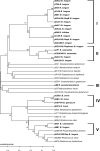Genomic insights into bifidobacteria
- PMID: 20805404
- PMCID: PMC2937518
- DOI: 10.1128/MMBR.00004-10
Genomic insights into bifidobacteria
Abstract
Since the discovery in 1899 of bifidobacteria as numerically dominant microbes in the feces of breast-fed infants, there have been numerous studies addressing their role in modulating gut microflora as well as their other potential health benefits. Because of this, they are frequently incorporated into foods as probiotic cultures. An understanding of their full interactions with intestinal microbes and the host is needed to scientifically validate any health benefits they may afford. Recently, the genome sequences of nine strains representing four species of Bifidobacterium became available. A comparative genome analysis of these genomes reveals a likely efficient capacity to adapt to their habitats, with B. longum subsp. infantis exhibiting more genomic potential to utilize human milk oligosaccharides, consistent with its habitat in the infant gut. Conversely, B. longum subsp. longum exhibits a higher genomic potential for utilization of plant-derived complex carbohydrates and polyols, consistent with its habitat in an adult gut. An intriguing observation is the loss of much of this genome potential when strains are adapted to pure culture environments, as highlighted by the genomes of B. animalis subsp. lactis strains, which exhibit the least potential for a gut habitat and are believed to have evolved from the B. animalis species during adaptation to dairy fermentation environments.
Figures








Similar articles
-
Broad conservation of milk utilization genes in Bifidobacterium longum subsp. infantis as revealed by comparative genomic hybridization.Appl Environ Microbiol. 2010 Nov;76(22):7373-81. doi: 10.1128/AEM.00675-10. Epub 2010 Aug 27. Appl Environ Microbiol. 2010. PMID: 20802066 Free PMC article.
-
Fucosyllactose and L-fucose utilization of infant Bifidobacterium longum and Bifidobacterium kashiwanohense.BMC Microbiol. 2016 Oct 26;16(1):248. doi: 10.1186/s12866-016-0867-4. BMC Microbiol. 2016. PMID: 27782805 Free PMC article.
-
Galacto- and Fructo-oligosaccharides Utilized for Growth by Cocultures of Bifidobacterial Species Characteristic of the Infant Gut.Appl Environ Microbiol. 2020 May 19;86(11):e00214-20. doi: 10.1128/AEM.00214-20. Print 2020 May 19. Appl Environ Microbiol. 2020. PMID: 32220841 Free PMC article.
-
A molecular basis for bifidobacterial enrichment in the infant gastrointestinal tract.Adv Nutr. 2012 May 1;3(3):415S-21S. doi: 10.3945/an.111.001586. Adv Nutr. 2012. PMID: 22585920 Free PMC article. Review.
-
Bosom Buddies: The Symbiotic Relationship Between Infants and Bifidobacterium longum ssp. longum and ssp. infantis. Genetic and Probiotic Features.Annu Rev Food Sci Technol. 2016;7:1-21. doi: 10.1146/annurev-food-041715-033151. Annu Rev Food Sci Technol. 2016. PMID: 26934170 Review.
Cited by
-
Transposon mutagenesis in Bifidobacterium breve: construction and characterization of a Tn5 transposon mutant library for Bifidobacterium breve UCC2003.PLoS One. 2013 May 30;8(5):e64699. doi: 10.1371/journal.pone.0064699. Print 2013. PLoS One. 2013. PMID: 23737995 Free PMC article.
-
A cross-sectional analysis from the Mykinso Cohort Study: establishing reference ranges for Japanese gut microbial indices.Biosci Microbiota Food Health. 2021;40(2):123-134. doi: 10.12938/bmfh.2020-038. Epub 2021 Feb 10. Biosci Microbiota Food Health. 2021. PMID: 33996369 Free PMC article.
-
Assessment of Probiotic Viability during Cheddar Cheese Manufacture and Ripening Using Propidium Monoazide-PCR Quantification.Front Microbiol. 2012 Oct 4;3:350. doi: 10.3389/fmicb.2012.00350. eCollection 2012. Front Microbiol. 2012. PMID: 23060868 Free PMC article.
-
Identification of conserved genomic signatures specific to Bifidobacterium species colonising the human gut.3 Biotech. 2023 Mar;13(3):97. doi: 10.1007/s13205-023-03492-4. Epub 2023 Feb 24. 3 Biotech. 2023. PMID: 36852175 Free PMC article.
-
Isomaltooligosaccharides utilization and genomic characterization of human infant anti-inflammatory Bifidobacterium longum and Bifidobacterium breve strains.3 Biotech. 2022 Apr;12(4):89. doi: 10.1007/s13205-022-03141-2. Epub 2022 Mar 7. 3 Biotech. 2022. PMID: 35299989 Free PMC article.
References
-
- Adam, A. 1949. Substitute for human milk in infant feedings. A contribution to the establishment of an artificial bifidus flora. Monatsschr. Kinderheilkd. 97:500-507.
-
- Agrawal, A., L. A. Houghton, J. Morris, B. Reilly, D. Guyonnet, N. Goupil Feuillerat, A. Schlumberger, S. Jakob, and P. J. Whorwell. 2008. Clinical trial: the effects of a fermented milk product containing Bifidobacterium lactis DN-173-010 on abdominal distension and gastrointestinal transit in irritable bowel syndrome with constipation. Aliment. Pharmacol. Ther. 29:104-114. - PubMed
-
- Alvarez-Martin, P., M. O'Connell-Motherway, D. van Sinderen, and B. Mayo. 2007. Functional analysis of the pBC1 replicon from Bifidobacterium catenulatum L48. Appl. Microbiol. Biotechnol. 76:1395-1402. - PubMed
Publication types
MeSH terms
Substances
LinkOut - more resources
Full Text Sources
Other Literature Sources
Molecular Biology Databases

